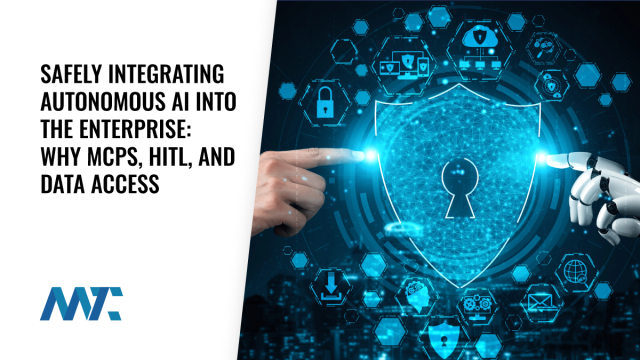As enterprises race to harness the productivity and automation potential of artificial intelligence (AI) and machine learning (ML), a new architectural problem has emerged—how do you safely allow autonomous systems to interact with sensitive data and core business systems without compromising security, compliance, or operational integrity?
This isn’t a theoretical concern. Autonomous agents can now make decisions, trigger workflows, and integrate across systems—from CRMs and ERPs to cloud file storage and customer support platforms. But this power comes with real risks. A model that can delete records, expose personally identifiable information (PII), or misinterpret a system’s API schema can create catastrophic outcomes at scale.
The solution isn’t to slow down innovation. It’s to deploy a modern enterprise architecture that allows autonomous AI systems to operate intelligently, but within strict, observable boundaries. That architecture consists of three critical layers:
Table of Contents
The Model Connection Platform (MCP)The Data Access Gateway: Protecting What Matters MostHuman-in-the-Loop (HITL)
The Model Connection Platform (MCP)
The MCP is AI’s Command and Control Layer, the central hub for autonomous models interacting with internal systems and external APIs. Rather than allowing an AI agent to make direct calls to backend systems, the MCP acts as an intermediary that evaluates, interprets, and manages these requests.
It governs model behavior through a set of rules and execution logic, determining:
Whether an action is permitted
Which API or service endpoint to call
How to structure or transform the request
What credentials or permissions are required
Whether a human should review the action before it is executed
By acting as a programmable decision layer between the model and operational systems, the MCP enforces business logic, policy compliance, and safety checks that AI systems cannot manage independently.
The Data Access Gateway: Protecting What Matters Most
If the MCP governs actions, the Data Access Gateway governs information. It provides a secure, policy-enforced interface between enterprise AI systems and sensitive business data, whether structured in databases, unstructured documents, or distributed across cloud platforms.
This layer ensures that even when a model requests access to data, it only receives what it is authorized to see. It enforces:
Field-level controls, including PII masking or redaction
Context-aware filtering based on user roles or agent scopes
Access throttling, query shaping, or content obfuscation
Logging and audit trails for every data interaction
The gateway ensures that AI systems operate with least privilege, gaining access only to the minimum amount of data necessary to perform their function. This is essential for compliance with data privacy regulations such as GDPR, HIPAA, and CCPA—and it also minimizes business risk.
Human-in-the-Loop (HITL)
Even the most well-governed model can occasionally produce actions or recommendations that exceed the boundaries of safety, legality, or business appropriateness. That’s why a third architectural layer—HITL is essential.
HITL introduces human review at critical moments in the AI’s decision-making or execution process. Rather than allowing models to act unilaterally, HITL workflows require human approval for:
High-impact actions, such as issuing refunds or canceling accounts
Sensitive communications, such as outbound emails or public messaging
Complex decision-making, such as compliance interpretation or legal summarization
Any gray-area scenarios where context or judgment is needed
This layer doesn’t limit AI capability—it augments it. Businesses get the best of both worlds by routing questionable or impactful actions through a human reviewer: speed and scale from AI, with control and discernment from human oversight.
Why This Architecture Matters to Executives
The implications are clear for CDOs, CIOs, CTOs, CMOs, and other enterprise leaders. Without this layered architecture, AI adoption can feel like a gamble. But with it, AI becomes a scalable, compliant, and trusted part of the operational fabric.
This structure ensures:
Sensitive systems are never exposed directly to AI models
Data access is tightly controlled, auditable, and compliant
Human judgment is injected into high-risk decisions
Business continuity is protected from unintended AI errors
It also supports standardization across departments. Central governance becomes critical as AI systems proliferate—from marketing to operations to customer success. The MCP and Data Gateway allow consistent controls, while HITL enables department-specific risk tolerance.
A Roadmap to Enterprise-Ready AI
Most organizations don’t implement this all at once. They evolve into it. A phased approach might look like:
Controlled pilot projects with read-only AI agents
Introduction of the MCP to route and restrict actions
Deployment of a Data Access Gateway to protect information boundaries
Implementation of HITL workflows for escalation and review
Full-scale adoption of autonomous AI with enterprise guardrails in place
AI Without Guardrails Is Just Risk at Scale
Enterprise AI is too powerful to operate without structure. That’s not an argument for constraint—it’s an argument for thoughtful design. With an MCP to mediate access, a Data Gateway to enforce data protection, and HITL to provide human judgment, companies can unlock the full potential of autonomous AI systems—without opening the door to unintended harm.
This layered architecture isn’t just about preventing disaster. It’s about operationalizing trust, which is the real competitive advantage for AI-ready enterprises.
©2025 DK New Media, LLC, All rights reserved | Disclosure
Originally Published on Martech Zone: Safely Integrating Autonomous AI Into the Enterprise: Why MCPs, HITL, and Data Access Gateways Are Non-Negotiable

